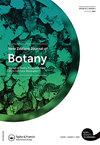本文介绍了科氏Phormium colensoi Hook.f的命名历史。
IF 1.4
4区 生物学
Q4 PLANT SCIENCES
引用次数: 0
摘要
摘要综述了科氏石鸡复杂的命名历史。这个名字和一个非常简短的验证性描述都归功于约瑟夫·道尔顿·胡克,于1848年发表在Le Jolis的一篇文章中。描述的简洁性不影响出版物的有效性,此处接受该名称为有效发布。讨论了Banks&Solander和Colenso对聚会的间接引用,以确定原始材料。在这项研究中,在Colenso访问的植物附近发现的植物具有多种表型,Banks和Solander标本似乎也显示出不止一种表型。因此,此时没有指定选择类型。文中还讨论了P.colensoi可能的同义词。Phormium coocianum Le Jol。是新西兰植物学家目前认可的名称,但历史上并非总是如此。邱园的Le Jolis标本被指定为库克P.coocianum的选择型。库克假单胞菌是一个临时名称,因此无效的可能性被驳回。黄曲霉是一个有效发表的同义词,但它是多余的和非法的。Phormium hookeri Gunn ex Hook.f.,通常被认为是P.coocianum的一个亚种,可能与P.colensoi的表型没有足够的差异,无法证明在该物种下具有相同的等级。新西兰植物学家得出的结论是,欧洲关于Phormium的作家被他们手头的有限材料误导了。一个悬而未决的问题仍然是,科伦索和库克藻的部分或全部原始标本是否可能是杂交起源。在完成必要的分类学工作(遗传学和种群研究)之前,Phormium物种的命名应被视为一个悬而未决的问题,而不是纯粹根据出版日期来决定。本文章由计算机程序翻译,如有差异,请以英文原文为准。
The nomenclatural history of Phormium colensoi Hook.f.
ABSTRACT The complicated nomenclatural history of Phormium colensoi Hook.f. is reviewed. The name and a very brief validating description, both attributed to Joseph Dalton Hooker, were published in 1848 in an article by Le Jolis. The brevity of the description does not affect the validity of the publication, and the name is here accepted as validly published. Indirect references to gatherings by Banks & Solander and by Colenso are discussed to identify original material. Plants seen during this study at localities close to those visited by Colenso have a diverse range of phenotypes, and Banks & Solander specimens also seem to show more than a single phenotype. A lectotype is therefore not designated at this time. Possible synonyms for P. colensoi are also discussed. Phormium cookianum Le Jol. is the name currently recognised by New Zealand botanists, but this has not historically always been the case. A Le Jolis specimen at Kew is designated as lectotype for P. cookianum. The possibility that P. cookianum is a provisional name, and is therefore invalid, is rejected. Phormium forsterianum Colenso is a validly published synonym, but is superfluous and illegitimate. Phormium hookeri Gunn ex Hook.f., commonly regarded as a subspecies of P. cookianum, may not be sufficiently different from phenotypes of P. colensoi to justify the same rank under that species. The conclusion by New Zealand botanists is that European writers on Phormium were greatly misled by the limited material they had to hand. An open question remains as to whether some or all the original specimens of P. colensoi and P. cookianum might be of hybrid origin. Until the necessary taxonomic work (genetic and population studies) has been done, the nomenclature of Phormium species should be regarded as an open question rather than being decided purely on publication dates.
求助全文
通过发布文献求助,成功后即可免费获取论文全文。
去求助
来源期刊

New Zealand Journal of Botany
生物-植物科学
CiteScore
2.20
自引率
22.20%
发文量
27
审稿时长
>12 weeks
期刊介绍:
The New Zealand Journal of Botany publishes original research papers, review papers, perspectives, short communications, forum articles, letter and book reviews. We welcome submissions relevant to all aspects of the botany, mycology, and phycology of the South Pacific, Australia, South America, and Southern Africa. The journal’s subject matter encompasses biosystematics and biogeography, ecology, physiology, biochemistry, genetics, reproductive biology, structure and development, taxonomy, ethnobotany, palaeobotany, bryology, lichenology, mycology, plant pathology, and phycology.
 求助内容:
求助内容: 应助结果提醒方式:
应助结果提醒方式:


